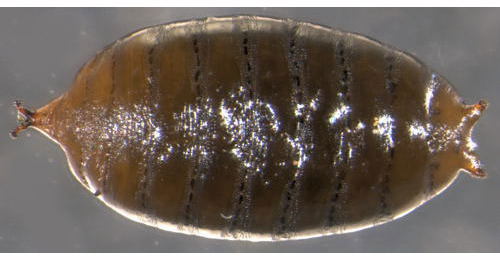|
||||||
| Aulagromyza
heringii (Hendel, 1920) [Diptera: Agromyzidae] |
||||||||||||||||||||||||||||||||||||||||||||||||||||||||||||||||||
|
Napomyza
heringii Hendel, 1920. Arch. Naturgesch. 84A(7)
(1918): 149, as Heringii |
||||||||||||||||||||||||||||||||||||||||||||||||||||||||||||||||||
|
Leaf-miner: A short linear-blotch mine, beginning with a small yellowish-brown pustule. Pupation external (Spencer, 1976: 315, 317 (fig. 569)). Greenish, later blackish, tortuous or irregularly star-shaped, upper-surface corridor, rather strongly widening in the end, and usually forming a secondary blotch. Frass in the first part of the mine in two ill-defined rows. Primary and secondary feeding lines present, but short and criss-cross. Pupation within the mine; the anterior spiracles penetrate the upper epidermis (Bladmineerders van Europa). The mine is an upper surface linear mine, becoming a blotch, with two rows of frass (British leafminers). Larva: The larvae of flies are leg-less maggots without a head capsule (see examples). They never have thoracic or abdominal legs. They do not have chewing mouthparts, although they do have a characteristic cephalo-pharyngeal skeleton (see examples), usually visible internally through the body wall. The larva is described by de Meijere (1938), Allen (1958), Dempewolf (2001: 167) and illustrated in Bladmineerders van Europa. Puparium: The puparia of flies are formed within the hardened last larval skin or puparium and as a result sheaths enclosing head appendages, wings and legs are not visible externally (see examples). Yellowish-brown; posterior spiracles each with an ellipse of some 20 bulbs (Spencer, 1976: 315). The puparium is illustrated in Bladmineerders van Europa.
Hosts in Great Britain and Ireland:
Hosts elsewhere:
Time of year - mines: November. Time of year - adults: Apparently only a single generation per year. Distribution in Great Britain and Ireland: Recorded only from Surrey (Reigate), Middlesex (Scratch Wood) and Hertfordshire (Brookman's Park) (Spencer, 1972b: 65), Glamorgan and West Gloucestershire (NBN Atlas). Ireland (National Biodiversity Data Centre Map). Distribution elsewhere: Widespread in western Europe including Denmark, Norway, Sweden, Poland (Spencer, 1976: 315), The Netherlands (Bladmineerders van Europa), Germany (Spencer, 1976: 562; Dempewolf, 2001: 167), Czech Republic, European Turkey, French mainland and Romania (Fauna Europaea). Range extending eastwards to the Kirghiz Republic, Kazakstan and Uzbekistan (Spencer, 1976: 315). NBN Atlas links to known host species:
British and Irish Parasitoids in Britain and elsewhere:
|
| Last updated 09-Jul-2019 Brian Pitkin | ||

